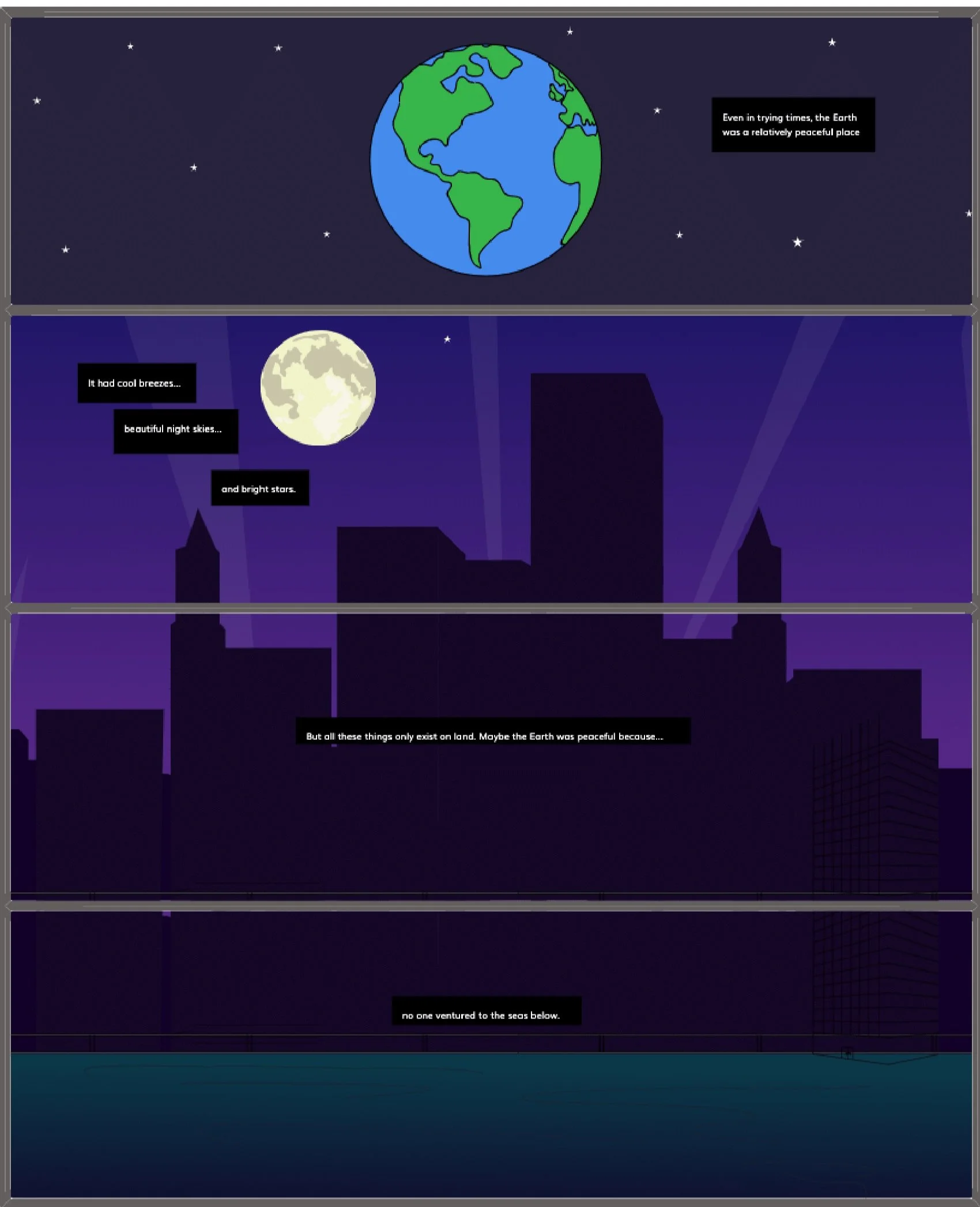What is the Difference Between Realism, Magic Realism, Surrealism, and Fabulism?
Realism, magic realism, surrealism, and fabulism are four different literary fiction styles. These are fantastic genres to explore in the creation of your next comic book or any form of literature.
Using a comic maker online is a great way to make a short comic that explores each of these subgenres. Check out our guide below for how to differentiate between realism, magic realism, surrealism, and fabulism.
Realism
Realism is the most straightforward of the four fiction styles. It is based on everyday reality, and ordinary occurrences, and attempts to portray life as it is. Characters, settings, and events are typically based on actual people and the natural world. Realism often focuses on creating a sense of authenticity and follows everyday life.
However, realism is still fiction and doesn't always portray life realistically.
Realism can have a dark twist: A very grudge dark take on reality - it could be a comic book that sheds light on social issues as its troubled main character battles the problems of every day while trying to escape their past.
Or a light-hearted high school drama: An everyday girl, in an everyday world, trying to pass pre-Calc while landing the boy of her dreams. There is a lot of variety within realism itself for you as the author to explore and use in your next book.
Pros of using realism in a comic book include:
1. Realism can help to ground the story in reality, making it more believable and engaging for readers.
2. Realistic settings and characters can help to create a richer and more immersive reading experience.
3. Realism can help to convey complex emotions and deeper connections with readers
4. Realism can be easier to write because it's based on the natural world.
Cons of using realism in comic books include:
1. The reader is accustomed to the setting which makes events seem normal and predictable to them. You may need to rely on more interesting characters to keep your readers engaged.
2. In realism, you must use basic logic, follow the natural order of the world, and use ordinary subjects/items. This may limit your artistic expression.
Use realism in your comic book if you want to create a believable story that will make your readers feel like they could meet or be your character and live in their world. Realism can help you ground your story in a relatable way, and it can also make your characters and their conflict more believable. Using realism can help create genuine tension and heighten the suspense in your story, making for a more engaging read and a deeper connection for the reader
Magic realism
Magic realism (also called magical realism) is a genre that combines elements of fantasy with realism. In magic realism, the magical or supernatural elements are presented as normal and commonplace, often without explanation.
Magical realists create comic books where the lines between reality and fiction are blurred. For example, in a magic realism comic, you could have a character who can transform into a bird. This wouldn't be explained and would just be accepted as part of their world.
Magic realism's focus is on where the ordinary and extraordinary can coexist. Magic realism or magical realism is similar to realism but incorporates magical or fantastical elements into a realistic world.
Magic realism vs Realism
In magic realism, magic and fantasy elements are normal and ingrained in everyday life. Some features of magic realism include
Fantastical elements such as magical creatures or powers
A mix of the ordinary and the extraordinary
A sense of wonder or mystery
Supernatural or surreal events happening in a realistic setting
Pros of using magical realism in a comic book include:
It can add an element of surprise or wonder to a story.
It can help to blur the line between reality and fantasy, making for an interesting and unique reading experience.
Cons of using magic realism in a comic book include:
The author may not be able to keep track of all the elements they introduced
Requires more planning than in realistic fiction
The magical elements inside a realistic setting may cause plot holes or inconsistencies
May lose sight of the story if there are too many unrealistic elements, making the story unbelievable & turning away reader
Use magic realism in your comic book if you want to bend reality by adding new features & fantastic elements to the world you already live in. Keep in mind, that it may take some effort to get things just the way you want them. Depending on how much you want to change, there may be some challenges that need to be faced and overcome. But with perseverance and a creative mind, anything is possible in magic realism.
Magical elements to include in your next comic book:
Magical creatures, such as fairies, elves, trolls, dragons, etc.
Magical powers or abilities, such as levitation, teleportation, etc.
Impossible events, such as a character turning into a bird or a house that flys
Mystical objects with special powers, like a magic lamp or a crystal ball
Magical events, such as time standing still or people turning into animals
A connection to the spiritual realm, such as talking to ghosts or seeing visions
Remember, the key to magic realism is to make the impossible seem like the everyday. With a little bit of creativity, you can come up with some truly magical elements to add to your story!
Comic book ideas with fantastical elements to include in your next comic book
A superhero comic about a girl who can manipulate time
A comic about a group of kids who find a portal to another world
A story about a woman who can transform into any animal she wants
A comic about a city that is constantly beset by giant monsters
Surrealism
Surrealism, in its most basic definition, means "above reality." Surrealist writers focus on telling a story or conveying meaning through language and/or imagery that is not necessarily in a logical order or would make sense in the natural world. However, the object or items in surrealism is grounded in reality.
Surrealism vs realism
Both surrealism and realism use ordinary objects and settings.
However, surrealism is more illogical with an artistic flair. Surrealism allows for greater creativity and flexibility in storytelling. Surrealism can be used to communicate ideas and messages that would be difficult or impossible to express through realism.
Second, surrealism can create a more visually interesting and striking comic book. With its weird and wonderful imagery, surrealism can really make your graphic novel stand out from the crowd.
Pros of using Surrealism in a comic book include:
Surrealism allows for a wide range of creativity and expression, which can be used to create interesting and unique characters and worlds.
Surrealist writers can communicate ideas and messages that would be difficult or impossible to express through realism.
Since surrealism is based on the subconscious, it can be used to explore complex and dream-like stories which can be difficult to tell in other genres.
Surrealism often employs a non-linear storytelling style, which can make for a more engaging and exciting read.
Cons of using Surrealism in a comic book include:
Since surrealism relies heavily on the use of symbolism, it can be difficult to explain to readers what is going on in the story.
The non-linear storytelling style of surrealism can also be confusing for readers if not executed properly.
Surrealism may not be the best genre for stories that are meant to be more realistic or down to earth, as the genre often skews towards the abstract and bizarre.
Use surrealism in your comic book if you want to experiment with the subconscious mind. Surrealism can be a great way to add an extra layer of depth and intrigue to your comic book. It can be a great way to add some extra flair to your work and can help you stand out from the crowd. However, surrealist writers, be cautious that surrealism can be confusing for readers. When used correctly, surrealism can take your readers on a truly unique and unforgettable journey.
Fabulism
Fabulism often employs devices such as dreams, unreliable narrations, and whimsically and impossible events. These elements can be used to explore the human condition in a new light.
In many ways, fabulism can be seen as a reaction against realism. It allows for a more imaginative approach to storytelling.
Fabulism vs Realism
Fabulism is often hard to describe, as it often defies other genre constraints. It may include science fiction, horror, and slipstream. It may have elements of myth and legends.
However, most of the items, creatures, and settings described in fabulism are simply made up and have little to know grounds in reality. At its core, it's about mystery and it is meant to spark curiosity and perplexity in the reader.
While fabulism is often used to explore serious topics, it can also be used simply for entertainment & pondering. Ultimately, it is up to the author to decide how to use this style.
Pros of using Fabulism in a comic book include:
Fabulism is a great opportunity to expand your creative storytelling skills and imagination.
Fabulism leaves a lasting impression on the reader as the author guides them through a story beyond the constraints of reality and impossible events
Fabulism can be easier to write because the author has more freedom from traditional story structure due to Fabulism's focus on imagination and impressions
Cons of using Fabulism in the comic book include:
It can be difficult to find an audience and describe your book to other
It may be difficult to write because originality is super important in a genre based on imagination
Difficult to convey/draw the story you want to tell. In Fabulism completely new creatures and items are conjured up by the author, so the words and phrases needed to describe your ideas can be difficult to come by (but not impossible)
Use Fabulism in your comic book if you want to create a story with elements of mythology, folklore, or religion. Also, look into fabulism if you would like your comic to be super abstract! If you want to create a story that is completely original and imaginative, then this genre may be for you. Just be warned it can be difficult to write and draw a completely new world. But if you're up for the challenge, go for it!
Use an online comic book maker to bring your ideas to life!
Each of these fiction literary styles realism, magical realism, surrealism, and fabulism have their own unique characteristics that make them stand out from one another
In this article, you learned the difference between surrealism, realism and fabulism. No matter which style of comic book you choose to write or draw in, it is important that your work has some level of clarity for readers to grasp on to.
Drawing magical realism, realism, surrealism, and fabulism can be difficult use an online comic maker like storyspread.com to create your magical realism comic without drawing.
Or if you need help learning about online comic creators check out our blog post "How to Use a Comic Maker Online to Create a Webcomic"
Hi, Welcome to Storyspread.com!
Comic creation made simple. Create graphic novels with a single click. Add character, backgrounds, and more.
Easy to use. Say goodbye to searching far & wide for an expensive illustrator.
Tell your story. Join other creatives, readers, and hobbyist in producing high quality & beautiful comics
Read. Read other’s comics for FREE and share with others
Grow. Grow an audience you love with the stories YOU imagined
Were you can create a comic and graphic novel WITHOUT drawing. Simple and easy! Made for all skill levels. Click-n-drag comic book characters, scences into panels.
Create a comic just like this! Here.





